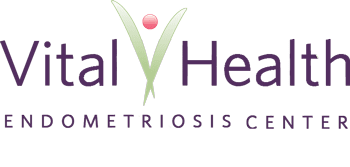Combinational birth control pills (contain both estrogen and progesterone) are commonly the first step in treating patients with endometriosis, pelvic pain and painful periods. If most of the pain a woman is experiencing is around her period then reducing the intensity of pain and/or the frequency of periods with the use of birth control pills may be an effective endometriosis treatment in some patients. With cyclic use of birth controls pills for treatment of endometriosis-associated menstrual cramps, the period is often lighter with decreased pain. Some women can take the pill continuously (skipping the sugar pills each month and taking hormone pills every day without a break,) either completely avoiding periods or significantly reducing the number of periods over time (for example 4 periods a year instead of 12 periods a year).
Even though this endometriosis treatment involves actually taking estrogen and progesterone, women taking a combinational birth control every day actually experience a significant reduction in the amount of estrogen and progesterone in their body. At first, this may not make sense but the ovaries make a lot more estrogen than that found in the pill. The small consistent does of estrogen and progesterone in the pill is enough to signal the ovaries not to make estrogen, temporarily turning the ovaries off and eliminating their relatively large release of estrogen. Less estrogen in the body as a result of the pill can result in less stimulation and activity of the endometriosis. Periods are usually shorter and lighter on the pill because there are less stimulation and growth of the endometrium (inside lining of the uterus that sloughs off during menstruation).
The most common treatment option in this category is the standard combinational estrogen/progesterone birth control pill. Other forms of combinational estrogen/progesterone treatment include the Nuvaring and the Ortho-Evra patch. The patch, however, delivers about 50% more estrogen than a standard 35mcg birth control pill and thus is not the best for endometriosis treatment.
If your doctor prescribes a particular birth control pill as treatment to help with your endometriosis symptoms hopefully it will work well without any side effects. In these cases, you have found a good treatment option for your endometriosis (note, while the treatment may manage your symptoms it does not eradicate the disease).
Unfortunately, the pill does not always work well or patients may have significant side effects. In these cases, a different birth control pill may work better, but there are so many birth control pills on the market it can be confusing trying to decide which option is right for you. Not all birth control pills are the same. Understanding these differences will help you and your doctor choose the best birth control pill option to treat your endometriosis symptoms while minimizing the side effects you may experience.
The difference in the various pills really comes down to a couple of things including the amount of estrogen, the type and amount of progestin and the balance or relative amount (ratio) of estrogen and progesterone. The type of estrogen is the same in virtually all of the combinational birth control pills (Ethinyl Estradiol). The amount of this estrogen in the pill can vary from 10 micrograms (micrograms=mcg) to 35mcg. The combinational pill has one of eight types of progestin (substance with progesterone-like activity). The types of progestin in the pill include norgestimate, desogestrel, norethindrone, norethindrone acetate, ethynodiol diacetate, drospirenone, levonorgestrel, and norgestrel. Nuvaring has a different progestin than found in any pill and is called etonogestrel.
Side effects
If you have any significant side effects (nausea, decreased sex drive, not feeling well, etc.) with this treatment option, using a pill with a different type of progestin or estrogen dose may work better for you. One of the more common side effects patients experience is breakthrough bleeding, that is bleeding in between the normal period time. This is often associated with cramping and pain. Birth control pills in part provide an effective option for endometriosis treatment by eliminating or reducing the number of bleeding and pain days. Often bleeding in between the period is a result of either the wrong overall estrogen level or the ratio of estrogen and progestin. There are over 100 different brands of combinational birth control pills. If the pill your doctor has given you as the best treatment option for your endometriosis but you still have cramping and bleeding, find your pill on the tables below. Perhaps even make a copy and take it with you to your next doctor appointment and see if there might be a better birth control pill option for your endometriosis treatment. A pill with a different estrogen level, a different type of progestin or different ratio of estrogen and progestin may be a better option for managing your pelvic pain.
Break Through Bleeding (BTB) and continued pain while taking BCP
There are many causes of BTB on the pill and your OB/GYN should be able to help resolve this for you. One of the many possible contributing factors to your BTB can be a dominance of either estrogen or progesterone. When your doctor performs a transvaginal ultrasound he or she will be able to measure the thickness of the endometrium (the inner lining of the uterus). BTB can be the result from the lining of the uterus being either too thick or too thin. If you are on the pill, changing the balance of the estrogen and progestin in the pill may help.
If the endometrium is thin on the sonogram (<5) one treatment option is to switch to a higher estrogen pill (or less progestin) and or higher estrogen to progestin ratio pill. If the endometrium is thick on the sonogram (>5) one treatment option is to switch to a lower amount of estrogen in the pill and/or a pill with a lower estrogen to progestin ratio or a progestin-only pill.

